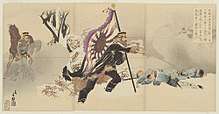Battle of Yingkou
The Battle of Yinkou (Japanese: Gyūsō sakusen (牛莊作戦)) was a land battle of the First Sino-Japanese War between the forces of Meiji Japan and Qing China, fought outside the treaty port town of Yingkou, Manchuria. It is sometimes referred to as the Battle of Niuzhuang or Newchwang.
| Battle of Yingkou | |||||||
|---|---|---|---|---|---|---|---|
| Part of the First Sino-Japanese War | |||||||
 Battle of Yingkou 1895, Unknown author | |||||||
| |||||||
| Belligerents | |||||||
|
|
| ||||||
| Commanders and leaders | |||||||
|
|
| ||||||
| Strength | |||||||
| 19,000 | 60,000 | ||||||
| Casualties and losses | |||||||
| 105 killed |
1,880 killed 698 wounded | ||||||
Background
Following the capture of the walled town of Haicheng, near Liaoyang in the Liaodong Peninsula, Manchuria by the 3rd Division of the Japanese First Army on 13 December 1894, Qing forces made four attempts in December and January 1895 to retake the town. This was the only Chinese offensive of the war, and all four attacks were unsuccessful. Military operations were hampered by deep snow and extremely severe winter weather.
On 10 January 1895, the Japanese Second Army launched a three-pronged attack on the walled city of Gaiping. Although the defenders resorted to freezing water on an incline to make it difficult for the Japanese to approach the walls, the city quickly fell. This severed the Qing lines of defense, and positioned the Japanese to strike either north to the ancient capital of Mukden, or east to the capital of Beijing.
The battle

Following the last attempt to retake Haicheng, Qing forces reinforced the port city of Niuzhuang with approximately 20,000 men, including a large force of cavalry. Another Qing force of around 20,000 men reinforced Liaoyang to the north, and on 1 February Viceroy Liu Kunyi arrived to assume overall command of Qing military operations.
Liu launched an attack with 16,000 men against the Japanese forces at Haicheng on 16 February. The attack was repulsed with a loss of 150 men killed and wounded. However, when news of the capture of Weihaiwei on 12 February by Japanese forces reached the Qing army, the attack was discontinued. Demoralized, many of the Qing forces began to desert.
On 28 February, Japanese forces under General Nozu Michitsura began a counterattack against Liaoyang and Niuzhuang, beginning with an artillery barrage and followed with an infantry offensive across a wide front. The Qing forces were driven in disorderly retreat to the northwest towards Jinzhou, offering only light and sporadic resistance. A portion of the Japanese army under Lieutenant General Katsura Tarō pursued the retreating Chinese to the walls of Liaoyang by 3 March, while the main force with the 3rd and IJA 5th Divisions under General Nozu reached Niuzhuang on 4 March.
After a two-hour-long artillery barrage, Qing forces abandoned the walls of Niuzhuang with almost no resistance, fleeing into town. However, with further retreat cutoff, the Qing forces resorted to urban warfare, contesting the city street-by-street in what was often hand-by-hand combat. However, by nightfall the fighting had ceased with a large number of Qing soldiers breaking through Japanese lines and fleeing into the countryside, and with the remainder (approximately 600 men) surrendering. As with previous campaigns, a large quantity of supplies and weapons were captured by the Japanese.
Following the capture of the city, Japanese forces under General Nogi Maresuke and Lieutenant General Yamaji Motoharu attacked and captured the coastal forts protecting the entrance to the treaty port of Niuzhuang, where Qing forces were attempting to regroup. On 6 March 1895, the Japanese forces proceeded to bombard the town of Tianzhuangtai on the opposite side of the Liao River, which they razed to the ground.
Aftermath of the battle
The capture of Yingkou marks the effective end of major combat on the Asian mainland in the First Sino-Japanese War, although the Imperial Japanese Army continued to push for permission from Imperial General Headquarters to continue on towards either Beijing or Mukden. On 24 March, the Japanese made an amphibious landing with several thousand troops on the Qing fortifications at Haichow in Jiangsu Province, north of Shanghai. The capture of these fortifications placed the Japanese within 50 miles of the strategic Grand Canal connecting Beijing with Nanjing. This applied more pressure on the Qing government to finalize discussions on ending the war, as did the Capture of the Pescadores near Taiwan at the end of March. Negotiations for the Treaty of Shimonoseki, which had begun on 20 March, were finalized by the Qing surrender on 17 April, ending the war.
References
- Chamberlin, William Henry. Japan Over Asia, 1937, Little, Brown, and Company, Boston, 395 pp.
- Kodansha Japan An Illustrated Encyclopedia, 1993, Kodansha Press, Tokyo ISBN 4-06-205938-X
- Lone, Stewart. Japan's First Modern War: Army and Society in the Conflict with China, 1894–1895, 1994, St. Martin's Press, New York, 222 pp.
- Paine, S. C. M. The Sino-Japanese War of 1894–1895: Perception, Power, and Primacy, 2003, Cambridge University Press, Cambridge, MA, 412 pp.
- Warner, Dennis and Peggy. The Tide at Sunrise, 1974, Charterhouse, New York, 659 pp.